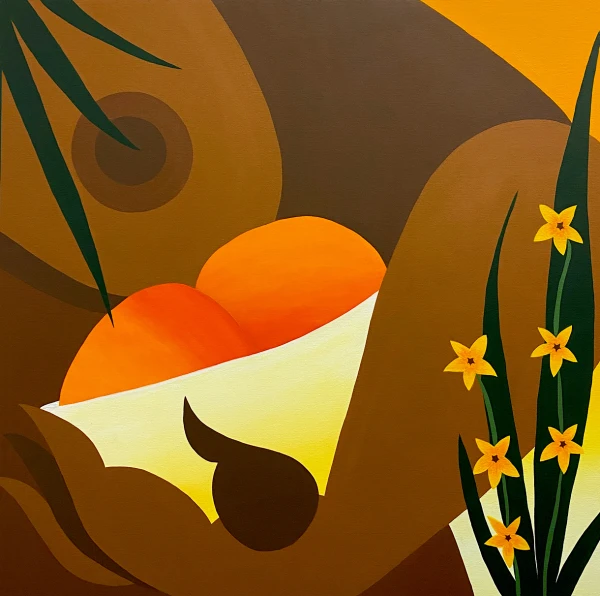In De Lo Mío, a Spectrum of Dominicanidad Seen Through Six Womxn Artists
Romi, 2021, Tiffany Alfonseca. Glitter, acrylic paint, and charcoal on stretched canvas. 48 x 60 inches (121.9 x 152.4 cm). Courtesy of the Artist and Jenkins Johnson Gallery, New York and San Francisco.
From a loud street corner in Little Dominican Republic, located in New York City’s Washington Heights, to a throbbing club in La Capital, on the island of Quisqueya, folks from the Dominican diaspora frequently exchange these three words: “De lo mío.” It’s a term of endearment reserved for homies, loved ones, and kin. A phrase laced with affection, warmth, and respect. This Dominicanism inspired the title of the recent exhibit, De Lo Mío, a captivating group show at Jenkins Johnson Projects featuring six emerging Dominican and Dominican-American womxn artists. The six artistic daughters of the diaspora included Tiffany Alfonseca (she/her), Uzumaki Cepeda (she/her), Mónica Hernández (she/her), Veronica Fernandez (she/her), Joiri Minaya (she/her), and Bianca Nemelc (she/her). De Lo Mío didn’t dwell on investigating “Dominican identity,” but focused more on these artists sharing their essences and lived experiences. Alfonseca, who also curated the exhibit, acted on a desire to share space with womxn artists of Dominican descent that she’s inspired by and showcase their personal truths in an organic way.
“To say ‘de lo mío’, those are the people that you fuck with,” shared Alfonseca. “And I’ve always fucked with this group of artists, specifically, those were the first artists that I discovered that were Dominican, or of Dominican heritage, or Dominican-American. And I always wanted to do something, like spotlighting or highlighting the culture. Because, I'm super big on my culture.”
On view last spring in a two-level townhouse nestled on Ocean Avenue in Brooklyn, the space offered some calming intimacy, instead of the stiffness of a typical white-box space in Chelsea. As a Black Dominican-American, it was thrilling to digest an all-womxn group show representing a multi-dimensional lens on Dominicanidad within a Black-owned space. I never expected De Lo Mío to feel monolithic, and why would it be? On the main floor works by Hernández, Alfonseca, Nemelc, and Fernandez, popped with vibrancy and figurative vigor, sparking inner dialogues around womxn’s bodies, love, sex, break-ups, family bonds, and Afro-Dominican representation.
Monica Hernandez. ghosted, 2019. oil on canvas. 72 x 48 in (182.9 x 121.9 cm). Courtesy of the Artist and Jenkins Johnson Gallery, New York and San Francisco.
Hernández is a Dominican-born, New York-based painter who depicts womxn of color exploring themselves within domestic spaces, from embracing sexual pleasure to rejecting patriarchal beauty norms (specifically body hair). Hernández’s large scale oil on canvas, titled dumped (2020), shows a nude, brown-skinned girl sitting on the toilet in her bathroom. She just shaved her head and looks out to a sunny view with her large expressive eyes. Maybe she’s processing heartbreak or plotting revenge, but by cutting her hair she is clearly prioritizing a step towards healing.
Alfonseca, who is a Bronx-based, Afro-Dominican-American, centers Black Latinx diasporic culture, and its nuances in her glitter and rhinestone-encrusted paintings. Alfonseca’s subject matter is warm and accessible; she vividly presents everyday moments familiar to us in a Dominican immigrant household, like tin cans of Bustelo sometimes used to rinse ourselves in the shower. “And for me, I wanted to show, like a little piece of me,” Alfonseca mentioned casually. “A lot of my art is based on memories, a lot of my memories were in DR in the summertime, growing up there. So I’ve always had a love for that country.” In Alfonseca’s No confío en tu mirada (2021), beautiful Black children against lush ferns stare out with a sense of autonomy.
Nemelc, a born and bred New Yorker of Dominican, Surinamese, and Indonesian descent, married two concepts wonderfully in her acrylic-based paintings—the brown female figure and nature. In Nemelc’s canvases, curvy womxn’s bodies in various shades of caramel and nutmeg, bask under sunshine and sunsets. In Dusk Beyond the Horizon (2021), the hills and slopes under a gradated lavender sunset outline a Caribbean woman’s physique, right down to her delicate areola.
Bianca Nemelc. Fruiting Body, 2020. Oil on canvas. 40 x 40 in (101.6 x 101.6 cm). Courtesy of the Artist and Jenkins Johnson Gallery, New York and San Francisco.
The six artists frame their varying relationships to their Dominicanness, their Blackness, their femininity, being bi-cultural, ideas of kinship, and larger ideas of Dominican womxnhood through visual methods that felt the most essential, freeing, and honest. In curating De Lo Mío, Alfonseca reflected, “I feel like for this show, everybody has such a totally different experience, some are super close to their heritage, some aren’t.” The mixed media artist tapped fellow peers she respects, specifically womxn of Dominican descent from her online art community, and mostly from Instagram. She wanted to showcase a range of aesthetics, moods, and urgent personal narratives from artists that didn’t rehash simplistic Dominican tropes, instead “having girls that aren't related so much to the culture.” “They don’t have to have such a tight bond to the culture, they can also have no ties to the culture as well,” Alfonseca noted. “So that was my goal, all types of relationships to DR.” As a curator, Alfonseca succeeded in this, because the takeaways in De Lo Mío are varied, and super nuanced, especially with the range of mediums: oil and acrylic portraiture, collage, sculptural objects, and installation. Cepeda’s interactive and immersive installations were intentionally created as judgment-free, welcoming spaces for Black and brown folk, which I could mentally escape in, while Nemelc’s sensual acrylic canvases exalted the way Caribbean womxn’s bodies are built, and the pride felt in that.
De Lo Mío installation images courtesy of Jenkins Johnson Gallery.
De Lo Mío installation images courtesy of Jenkins Johnson Gallery.
Uzumaki Cepeda. Stuck Between a Rock and a Hard Place, 2021. Fur on found objects, dimensions variable. Courtesy of the Artist and Jenkins Johnson Gallery, New York and San Francisco.
In the gallery’s lower level, one could dive deeper into Cepeda’s fantasy-filled, faux fur installations. Cepeda, a Bronx-born, first-gen, Dominican-American textile artist, painter, and sculptor, works with found objects and faux fur to construct dream-like, playful environments inspired by her Dominican heritage and being an internet kid. These installations existed as soft spaces crafted by Cepeda that provided mental and physical rest for BIPOC and QTBIPOC. In Stuck Between a Rock and a Hard Place (2021), the soothing installation was covered in pastel-hued faux fur, and featured a furry lamp, stool, table, throw pillows, and two faux fur paintings. This room functions as a metaphor for therapy and healing, a pitstop for Black and brown folk to find a gentle release from the various systemic ‘isms’ and ‘phobias.’
Veronica Fernandez. Growing With Risks (Three), 2020. Oil on canvas. 60 x 48 in. Courtesy of the Artist and Jenkins Johnson Gallery, New York and San Francisco.
Veronica Fernandez’s frenetic, color-saturated, oil paintings pull from memories and personal objects, and added a mysterious element to the exhibit. Fernandez’s bold and large canvases, which slightly border on semi-abstract elements, and often blur out figures, draw connections between people and places. For the Los Angeles-based, Dominican-American mixed media artist, our ever-shifting memories and the spaces we inhabit carry weight. In Growing with Risks (three) (2020), a family portrait bursting with shades of crimson and magenta seems fragmented, and in Four Branches (2021), an elder family member draped in blue seems almost ghost-like.
Joiri Minaya’s Internet-sourced collages, from her series #dominicanwomengooglesearch, are small-scale yet powerful works within the exhibit. In her collage series, the Dominican-United Statesian multi-disciplinary artist explores the sexual fetisization and exotification placed on Dominican womxn. But on the flip side, Minaya’s collages also showcase the agency and ownership Dominican womxn can assert over their own bodies, too. In a small nook within the downstairs gallery, Minaya’s piece, Continuum (2020), contrasts two Black womxn in one body against a tropical backdrop, one from a colonized past and another from a contemporary present, battling an unchanged objectified lens, centuries apart. In another collage piece, The upkeepers (2021), what seems like a vintage postcard of a womxn serving drinks, reveals a photograph of enslaved Black ancestors right at the center.
More of Alfonseca’s punchy acrylic and glittery paintings rounded out the exhibition. Alfonseca lovingly paints womxn that are so familiar to us, in all of their roles, as madres, tias, abuelas, hermanas, primas, and other queridas. In Milady (De La Vega) (2020), a tired and dutiful mother hangs up bright laundry on a clothesline. In Romi (2021), an ode to a domestic worker in Alfonseca’s family back in the DR, the portrait has pops of yellow on the cabinets and features bright blue kitchen rags. It paints a picture of Dominican womxn’s labor and the strides they take to maintain family units. Alfonseca shared, “that was una trabajadora that we had over there, that she’s been in the family for years—she’s still in our family—and that was pretty much to pay homage to her. Even though that is the norm over there, we don’t see her as a worker, we see her as family.”
Joiri Minaya, Untitled 1, 2020. Archival pigment print. 17 x 11 in. Courtesy of the Artist and Jenkins Johnson Gallery, New York and San Francisco.
The artists' Dominican roots are the obvious connector, but smaller threads between each of them can be found as well. Nemelc and Minaya explored Dominican womxn’s bodies, the ways in which they’re perceived, lusted after, and how they function within social and natural environments. Hernández and Cepeda imagined domestic spaces as sites for healing and intimacy. Alfonseca and Fernandez each culled from memories and used bright rich colors to construct complex family narratives. De Lo Mío stitched together six womxn artists’ collective experiences across the Dominican diaspora. Yet, each artist delivered singular moments and experiences that stayed with me, and will continue to remain with me.
This interview originally appeared on The Latinx Project’s Intervenxions in September 2021.













